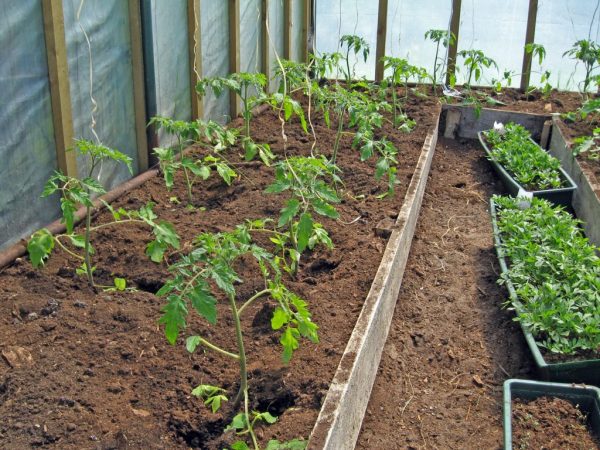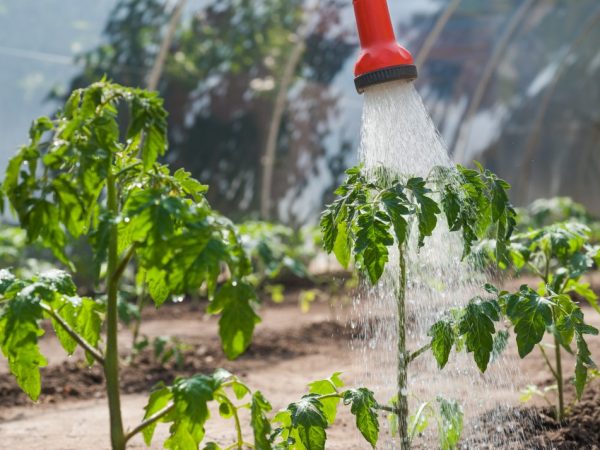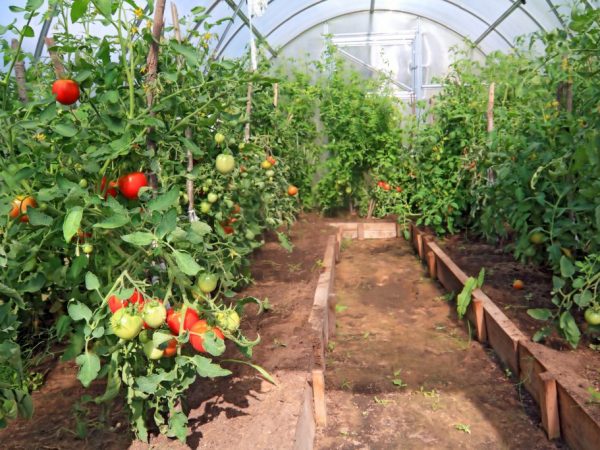Rules for feeding tomatoes in a greenhouse
Even if you plant tomato seedlings in sufficiently fertile soil located in a polycarbonate greenhouse, you will hardly be able to grow a good and rich harvest without additional baits with mineral elements. Consider when and how to feed tomatoes in a greenhouse so that they fully develop and bear fruit on time.
- Preparing for landing
- The soil
- Tomato seedlings
- Seed material
- Meals after disembarkation
- Nitrophoska
- Manganese
- Groundbait during flowering
- Sudarushka
- Self-preparation of fertilizers
- Foliar nutrition
- Nutrition for fruiting
- Superphosphate
- Boron and iodine
- Some Recommendations
- Groundbait frequency
- For strong seedlings
- For intensive growth

Rules for feeding tomatoes in a greenhouse
Preparing for landing
For planting grown seedlings in open ground, greenhouses recommend preparing the soil during digging and processing the seedlings themselves. Seed material for growing tomatoes in a greenhouse is fed.
The soil
The land in the greenhouse for the subsequent planting of tomatoes is prepared in autumn or spring. To fertilize the land and get a rich harvest, sod and peat are introduced into the soil in equal proportions (usually 1 bucket per 1 square meter of sown area). Organic matter is added to them: 0.5 liters of ash fertilizer, a 10-liter bucket of compost or humus, as well as 1 tsp each. urea per 1 sq. m beds.
Immediately before planting tomato seedlings or seeds, the soil is fertilized with potassium permanganate in a proportion of 1 g per 10-liter volume of water heated to a temperature of 60-80 ° C.
Tomato seedlings
Before planting tomato seedlings in a greenhouse, they are fed with yeast. To feed the sprouts, 1 sachet of dry yeast is enough, diluted in a glass of warm water with the addition of 2 tsp. granulated sugar. The one and a half liter mixture with yeast infused for 2 hours is increased with water to a volume of 10 liters. With this yeast fertilizer, tomato seedlings are watered before planting in a greenhouse.
Seed material
Dense seeds have better germination, so they are sorted based on this characteristic. For this, the seeds are immersed in an aqueous solution with table salt with a concentration of 3-5% or potassium nitrate with a concentration of 50 g per 1 liter. For planting in a greenhouse, only seeds that have settled to the bottom of the container are used.
The preparation for seed treatment is chosen, depending on the goals:
- to create the resistance of a vegetable crop to various diseases and infections, seed material is fed with potassium permanganate at the rate of 1 g per glass of water,
- to accelerate germination, seed material is soaked in wood ash (1 tablespoon per liter) or in a self-prepared solution with boric acid (0.02%), ammonium (0.01%), manganese sulfate (0.05%), copper (0.05%), potassium (0.025%). In both cases, to activate the process of germinating seeds, they are placed in the bait for 0.5 days at a temperature of at least 20 ° C.
After bait, tomato seeds are hardened, leaving for 12-24 hours in a refrigerator with a temperature of 1-2 ° C.Hardening the seed will allow the vegetable crop to adapt faster after planting and survive in cold climates, especially in the northern regions.
Meals after disembarkation
Fertilizing tomatoes in the greenhouse after planting seedlings or seed material is carried out several days after planting. When growing tomatoes from seeds, the initial feeding of tomatoes in the greenhouse is done 2 weeks after the sprouts appear. This usually happens in late May - early June.
A vegetable crop planted in a greenhouse primarily requires nitrogen, phosphorus and potassium-containing fertilizers.
Another answer to the question of how to feed tomatoes in a greenhouse after planting is nitrophoska and manganese.
In greenhouse conditions, humidity indicators are much higher than in the open air, therefore, the absorption of nutrient fertilizers by the plant is more active and in full. This is why it is necessary to feed tomatoes in the greenhouse for the first time with a reduced concentration of liquid compared to that used for vegetables grown in the open field.
Nitrophoska

For the initial feeding, a solution of nitrophoska with a mullein is suitable
Top dressing of tomatoes in a greenhouse with nitrofos is done as follows: 1 tbsp. l. mixed with 0.5 liters of mullein per 10 liter volume of water. The consumption rate for root top dressing of tomatoes in the greenhouse is 1 liter for each tomato bush.
Manganese
It is recommended to feed tomato seedlings in a greenhouse with potassium permanganate no more than once every 7 days. For this procedure, a weakly concentrated solution is made.
Groundbait during flowering
Be sure to feed the tomatoes in the greenhouse during the flowering stage. At the same time, to care for the plant, vegetable gardens use both ready-made nutritional complexes, micronutrient fertilizers, and prepare top dressing on their own.
Sudarushka
The universal complex of fertilizers Sudarushka has established itself as a good tool for root bait during the period when the first flowers appear. The finished chlorine-free fertilizer contains all the main components that ensure the full development of the culture:
- 13% nitrogen,
- 8% phosphorus and potassium,
- 0.15% zinc,
- 2% manganese
- 0.1% copper,
- 1.5% boron,
- 0.04% cobalt,
- 0.04% molybdenum.
For the working solution, 1 tsp is enough. finished fertilizer for 10 liters of water. The consumption rate of the finished composition is 0.5 liters for each tomato bush.
Self-preparation of fertilizers
Fertilizers for root groundbait of tomatoes at the flowering stage can be prepared by yourself. To do this, it is enough to mix the source components of the nutrients necessary for tomatoes:
- 1 liter of potassium sulfate,
- 0.5 l mullein,
- 10 liters of liquid.
The consumption rate of the fertilizer composition is a liter for each bush.
Foliar nutrition
Foliar feeding of tomatoes in a greenhouse also includes fertilizers with wood ash or magnesium.
Ash fertilizers
During the period of flowering and the formation of ovaries, ash spraying acts as a source of nutrients obtained through the foliage. Tomato leaves are sprayed in the evening. A working solution for foliar groundbait is made from 2 glasses of ash, filled with the same amount of heated water. The resulting mixture is kept for 2 days, then filtered, the volume is brought up to 10 liters with water, after which the tomato tops are sprayed.
Magnesium sulfate
Foliar feeding of tomatoes with magnesium sulfate affects the high-quality and active formation of ovaries. 15 g of fertilizer with magnesium is diluted in a 10-liter volume of water. Each bush should have 1.5 liters of solution.
Nutrition for fruiting

During fruiting, only root dressing is used.
At the fruiting stage, tomatoes in the greenhouse are fed for the last time. At this time, the plant needs iodine, potassium, boron, manganese.During the period when fruits appear on tomato bushes, only root bait is used, foliar nutrition is not used so that the fruits do not crack.
Superphosphate
Superphosphate is often used for root groundbait of tomatoes in the greenhouse. 2 tbsp. l. superphosphate is mixed with 1 tbsp. l. potassium humate and diluted with 10 liters of water. The feeding rate is one liter of finished fertilizer for each tomato bush.
Boron and iodine
Boric acid (10 g) mixed with iodine (10 ml) and ash (1.5 l) makes it possible to compensate for the lack of mineral elements required at the fruiting stage. An aqueous solution is made with these components by diluting them in a 10-liter volume of liquid. The consumption rate of the finished fertilizer is 1 liter for each tomato bush.
Some Recommendations
Groundbait frequency
Not a single summer resident will tell you how to feed tomatoes in a greenhouse and when to do it right. The timing is influenced by the variety of tomatoes, the climate and the health of the crop.
As a rule, the frequency of baits is 3-4 times over the entire gardening period, but can be increased if, with proper care, the appearance of the plants indicates a lack of mineral nutrition. In these cases, they begin to feed the problematic vegetable crop, applying fertilizers at intervals of 1.5-2 weeks, alternating root and foliar bait.
For strong seedlings
Often tomato seedlings try to stretch out in height, as a result of which the stem becomes thinner. The groundbait of tomatoes in the greenhouse, carried out after the pick, helps to make the seedlings stronger. To feed the tomatoes, mix superphosphate (20 g), ammonium nitrate (30 g), potassium sulfate (15 g), ash extract (100 g) and 10 liters of water. Tomatoes are recommended to be fed with this composition 2 weeks after the pick, repeated at the same interval.
For intensive growth
If tomatoes grow poorly and slowly in a greenhouse, they are fed with sodium humate. Root bait allows you to introduce a lack of sodium, as well as to get in return the activation of the growth of tomato bushes.
If the growth of tops and god shoots stops or slows down or leaves turn yellow, use nitrogen-containing fertilizers.
Among the folk remedies used to stimulate the growth of vegetable crops to increase yields, summer residents prefer organic matter. Simple nettle has proven itself well, the fermented infusion of which is used when root feeding of tomatoes in a greenhouse is required.


